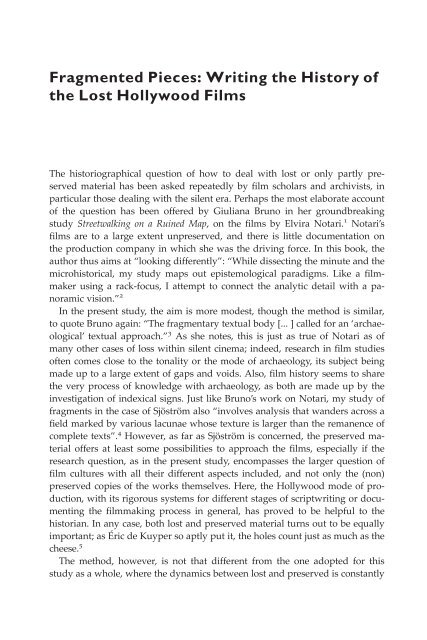FILM FILM - University of Macau Library
FILM FILM - University of Macau Library
FILM FILM - University of Macau Library
Create successful ePaper yourself
Turn your PDF publications into a flip-book with our unique Google optimized e-Paper software.
Fragmented Pieces: Writing the History <strong>of</strong><br />
the Lost Hollywood Films<br />
The historiographical question <strong>of</strong> how to deal with lost or only partly preserved<br />
material has been asked repeatedly by film scholars and archivists, in<br />
particular those dealing with the silent era. Perhaps the most elaborate account<br />
<strong>of</strong> the question has been <strong>of</strong>fered by Giuliana Bruno in her groundbreaking<br />
study Streetwalking on a Ruined Map, on the films by Elvira Notari. 1 Notari’s<br />
films are to a large extent unpreserved, and there is little documentation on<br />
the production company in which she was the driving force. In this book, the<br />
author thus aims at “looking differently”: “While dissecting the minute and the<br />
microhistorical, my study maps out epistemological paradigms. Like a filmmaker<br />
using a rack-focus, I attempt to connect the analytic detail with a panoramic<br />
vision.” 2<br />
In the present study, the aim is more modest, though the method is similar,<br />
to quote Bruno again: “The fragmentary textual body [... ] called for an ‘archaeological’<br />
textual approach.” 3 As she notes, this is just as true <strong>of</strong> Notari as <strong>of</strong><br />
many other cases <strong>of</strong> loss within silent cinema; indeed, research in film studies<br />
<strong>of</strong>ten comes close to the tonality or the mode <strong>of</strong> archaeology, its subject being<br />
made up to a large extent <strong>of</strong> gaps and voids. Also, film history seems to share<br />
the very process <strong>of</strong> knowledge with archaeology, as both are made up by the<br />
investigation <strong>of</strong> indexical signs. Just like Bruno’s work on Notari, my study <strong>of</strong><br />
fragments in the case <strong>of</strong> Sjöström also “involves analysis that wanders across a<br />
field marked by various lacunae whose texture is larger than the remanence <strong>of</strong><br />
complete texts”. 4 However, as far as Sjöström is concerned, the preserved material<br />
<strong>of</strong>fers at least some possibilities to approach the films, especially if the<br />
research question, as in the present study, encompasses the larger question <strong>of</strong><br />
film cultures with all their different aspects included, and not only the (non)<br />
preserved copies <strong>of</strong> the works themselves. Here, the Hollywood mode <strong>of</strong> production,<br />
with its rigorous systems for different stages <strong>of</strong> scriptwriting or documenting<br />
the filmmaking process in general, has proved to be helpful to the<br />
historian. In any case, both lost and preserved material turns out to be equally<br />
important; as Éric de Kuyper so aptly put it, the holes count just as much as the<br />
cheese. 5<br />
The method, however, is not that different from the one adopted for this<br />
study as a whole, where the dynamics between lost and preserved is constantly

















